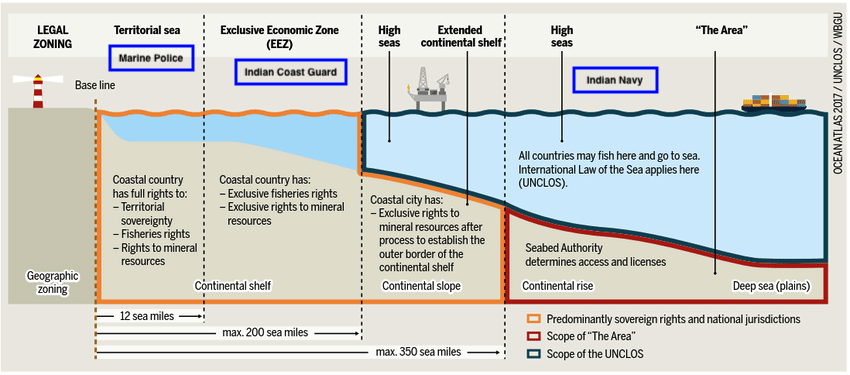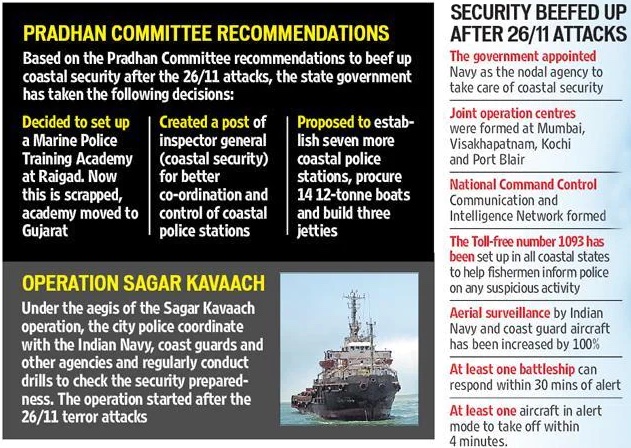ForumIAS announcing GS Foundation Program for UPSC CSE 2025-26 from 19 April. Click Here for more information.
ForumIAS Answer Writing Focus Group (AWFG) for Mains 2024 commencing from 24th June 2024. The Entrance Test for the program will be held on 28th April 2024 at 9 AM. To know more about the program visit: https://forumias.com/blog/awfg2024
Contents
| For 7PM Editorial Archives click HERE → |
Introduction
More than 600 million people, (~10% of the world’s population), live in coastal areas that are 10 meters above the sea level. Nearly 2.4 billion people (~40 % of the world’s population) live within 100 km of the coast. In India, three out of four metro cities are located on the coast. About 14.2% of the population in India lives in coastal districts. Around 95% of India’s trade by volume and 68% by value is conducted through these waters, with priority being accorded to port-led development plans in recent years. The offshore development areas are critical for securing India’s energy needs. India has one of the largest fishing fleets globally. Thus, oceans are the lifeline of prosperity and economic development. India has a long coastline of 7516 km along the mainland and island territories. India occupies a significant position in the maritime economics of the world trade overseeing the busiest of the international shipping lanes. There are 9 Coastal States, 4 Union Territories and 1295 islands spread along the coast of India, including the Andaman & Nicobar Islands in the east and Lakshadweep Islands in the west. The coastal areas host major commercial cities, and significant strategic and vital installations of Defence, Atomic Energy, Petroleum, and private ventures. In addition there 12 major ports and more than 239 non-major ports along the coastline, thus increasing the coastline’s vulnerability. In this context, ensuring coastal security becomes strategically important.
Coastal Security Challenges
Inimical neighbourhood sponsored cross-border terrorism makes India’s coastline vulnerable. This was evident during 26/11 terrorist attacks when Pakistan-sponsored terrorists entered India through sea-route and wrecked havoc in Mumbai. The explosives used to undertake terror attacks in Mumbai in 1993 were also smuggled through Arabian Sea.
Coastal Infrastructure including ports handling large volume of goods, including oil storage tanks are more vulnerable to attacks by terrorists.
In addition, coastal regions are becoming preferred route for arms and drug trafficking. Ensuring security of major shipping lanes is another major challenge.
The instances of piracy and robbery have been increasing especially in the Arabian Sea region proximal to Eastern Africa (like Somalia). Maritime ships including Indian ships engaged in trade are vulnerable to pirate attacks.
Instability in India’s neighbourhood make India’s coastline vulnerable to illegal migration and infiltration. Illegal infiltration from Pakistan, Bangladesh and Sri Lanka through sea route has been happening in Gujarat, West Bengal and Tamil Nadu etc.
Coastal Security Initiatives
Multiple Agencies for Coastal Security: The multi-agency concept mandates cooperation, coordination, and institutionalised domain control of the respective agency to achieve foolproof security by optimum utilisation of limited resources. Thus a tiered mechanism has been created with stakeholders like Indian Navy, Coast Guard and Coastal Police. In addition, Custom Authorities, Port Authorities, Intelligence Agencies and Other Union and State Departments are stakeholders in ocean governance.
Security Procedures: For effective coordination amongst all stakeholders involved in coastal security, Standard Operating Procedures (SOPs) for Coastal Security have been promulgated by the Indian Coast Guard in consultation with all stakeholders.
Maritime Exercises: To ensure a high degree of preparedness for responding to an immediate threat and to streamline the response to more significant threat perception, Coastal Security Exercise ‘Sagar Kavach‘ is conducted bi-annually for each coastal state.
Government focus on Coastal Infrastructure: (a) The Government of India has focused on the improvement of infrastructure and assets of the Indian Coast Guard and all concerned agencies to enhance their capabilities for surveillance and patrol at sea; (b) More than 200 Coastal Police Stations along with patrol boats have been established in the coastal States, including Island territories, for surveillance of shallow waters; (c) Measures such as coastal mapping, strengthening of security at non-major ports, setting up of State Maritime Boards by coastal States, and biometric identity cards for fishermen have also been implemented. These initiatives have been coordinated by Indian Coast Guard for over a decade and have given desirable results.
Technology: The integration of technology with surveillance methodology has been achieved by establishing Coastal Surveillance Network (CSN) for seaward electronic surveillance up to 25 Nautical Miles from the coast under which 46 remote radar stations have been established. 38 Radar stations, 4 Mobile Surveillance Systems and 13 Radar stations under VTMS (Vessel Traffic Management System) connectivity are being established for providing near gap-free surveillance.
Patrolling: Joint Coastal Patrol (JCP) by Indian Coast Guard and Coastal Police has been instituted across all coastal States and Union Territories wherein the Coastal Police Personnel are embarked onboard Coast Guard ships, and deployment is undertaken in coordination with electronic surveillance measures for optimum exploitation of resources. The surveillance of 1382 islands is maintained during routine sorties by Indian Coast Guard ships and aircraft. On average, 45-50 Coast Guard Ships and 10-12 aircraft are deployed daily for surveillance of India’s EEZ.
Monitoring and Coordination: The apex level monitoring and review of the implementation of measures for enhancing the effectiveness of the Coastal Security Framework are done by the National Committee on Strengthening of Maritime and Coastal Security (NCSMCS) against threats from the sea, Multi-Agency Maritime Security Group (MAMSG) under the NSA. The improved information sharing along with better inter-agency coordination and synergy is the hallmark of the coastal security framework.
Multi-Stakeholder Approach: A multi-stakeholder concept has been adopted post 26/11 for coastal security steered through Chief Secretaries of the respective coastal states and supervised by the Ministry of Home Affairs (MHA), through Border Management Division under the monitoring of the Cabinet Secretary through the NCSMCS. It provides an optimal approach to ensure time-bound implementation of all tasks and a high level of coordination among numerous stakeholders.
Source: Hindustan Times
Moving Ahead
First, There is need to initiate measures for surveillance in the depth of oceans as the threat to the coastline emanates in deeper waters much beyond the coastline.
Second, a legislative framework to establish systems and processes for the protection of India’s maritime infrastructure should be created. It will ensure the accountability of the Executive Agencies to the representatives of the people.
Third, The capabilities of Coastal Police should be further strengthened through enhancement of infrastructure (like patrol boats) and deployment of modern surveillance technologies.
Fourth, Inter-agency coordination can be further streamlined through clearly defined roles to prevent overlapping of authority and conflict.
Fifth, The Government should come up with a comprehensive National Security Doctrine, appropriately addressing Coastal Security concerns.
| Read More: Need for a National Security Doctrine for India – Explained, pointwise |
Conclusion
The Coastal Security Construct of the present day has successfully built synergy and coordination, which in the current security environment is very much required and must be continued. The mechanisms of inter-agency coordination should be made more robust and infrastructure should be upgraded to further enhance the Coastal Security Paradigm in India.
Syllabus: GS III, Security challenges and their and management
Source: Yojana November 2022, IDSA






